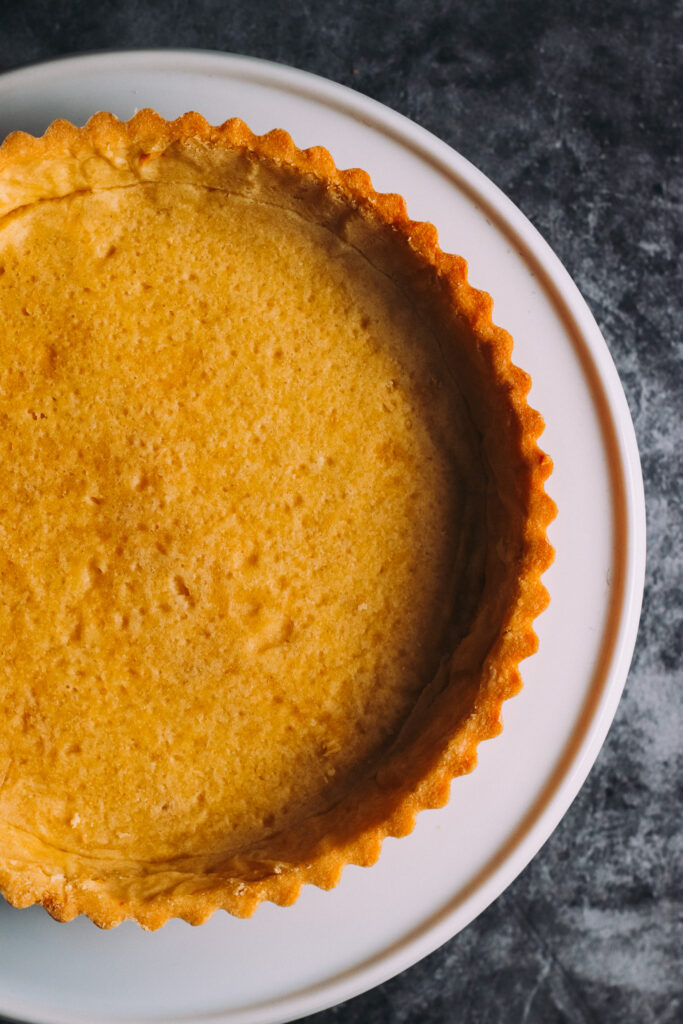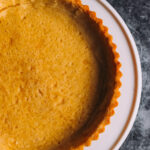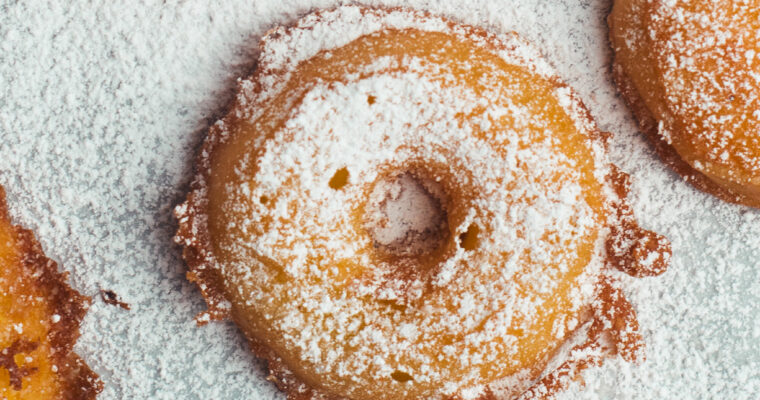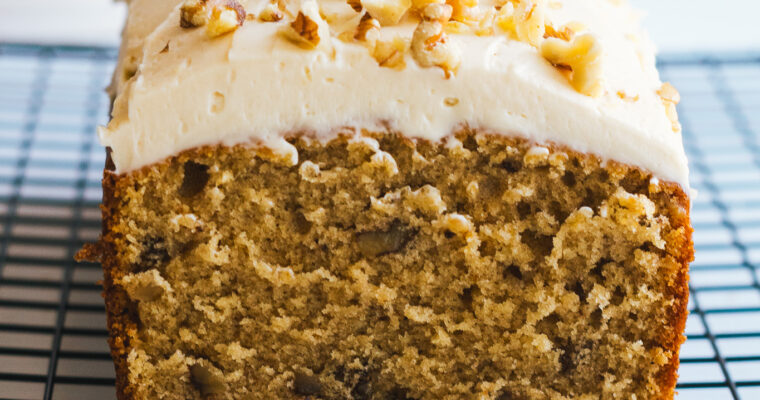Try my easy recipe for making sweet short pastry (paté sablée) and up your blind baking game with this simple hack…
What Is Paté Sablée
Before we dive into the details of perfecting Pate Sablee, let’s take a moment to understand what exactly it is. Pate Sablee is a French pastry dough with a sandy texture, thanks to its high butter content. It is commonly used as the base for fruit tarts, lemon tarts, and other sweet treats. This pastry dough is made with basic ingredients such as flour, butter, sugar, and egg yolks. The incorporation of these ingredients should be done gently to prevent gluten formation, ensuring a tender and delicate crust.
What Is Pate Sablee?
Pate Sablee, also known as sweet short pastry, is a classic French pastry dough that is used as the base for various desserts. Its sandy texture, buttery flavour, and golden brown colour make it a perfect canvas for showcasing sweet fillings. The basic ingredients of Pate Sablee include flour, butter, sugar, and egg yolks. These ingredients are gently incorporated to prevent gluten formation, resulting in a pastry dough that is both tender and crumbly. Pate Sablee adds a delightful texture and flavour to fruit tarts, lemon tarts, and other sweet treats, truly elevating them to the next level of deliciousness.
Importance of Pate Sablee in Baking
Pate Sablee plays a crucial role in baking, especially when it comes to creating delectable fruit tarts and other desserts. This pastry dough provides a stable and sturdy base for sweet fillings, such as pastry cream or fruit compotes. Its flaky texture adds a delightful contrast to the creamy and juicy fillings, making every bite a delightful experience. When prepared properly, Pate Sablee ensures a crisp and delicious end result, making it a favourite among bakers and pastry chefs. The golden brown colour of the crust, along with its buttery flavour, enhances the overall taste and presentation of the baked goods. So, whether you’re baking a classic fruit tart or experimenting with different sweet fillings, perfecting Pate Sablee is essential for achieving the best results.
Making Perfect Pate Sablee
Now that we understand the importance of Pate Sablee, let’s dive into the steps for making this pastry dough to perfection. It all starts with gathering the necessary ingredients and following a few key techniques. With the right ingredients and a few expert tips, you’ll be well on your way to creating the perfect Pate Sablee for all your baking endeavours.
Necessary Ingredients for Pate Sablee
To make perfect Pate Sablee, you will need the following ingredients:
- Plain flour: The base of any pastry dough, purpose flour provides structure and stability to the crust.
- Cold butter: Cold butter is essential for creating a flaky texture in Pate Sablee. It should be cut into small pieces and added to the dough.
- Egg yolk: The egg yolk adds richness and helps bind the dough together, resulting in a delicate and crumbly texture.
- Sugar: A small amount of sugar is added to sweeten the dough and enhance its flavour.
- Salt: A pinch of salt balances the sweetness of the dough and enhances the overall flavour profile.
Salted vs. Unsalted Butter
For a perfect paté sablée, unsalted butter is an essential ingredient that adds richness and flavour to the delicate pastry. The butter should be cold and cut into small pieces to ensure a flaky and tender crust. Combined with all-purpose flour, powdered sugar, and a touch of fine sea salt, unsalted butter creates the perfect base for this classic French pastry that is both buttery and crumbly in texture. You can use salted butter but it can be difficult to be certain how much salt is being added. This can affect the end flavour profile, so unsalted butter is best to use here.
How to Make Shortcrust Pastry (pate sucree vs pate sablee)
There are different ways to make shortcrust pastry. This recipe is based upon rubbing butter into flour. Pate sucree is another way to make sweet shortcrust and involves using room temperature butter and creaming the butter with the sugar first for a crisper type of crust. Both methods are used to minimize activating the gluten and making the dough elastic. The one we are all most familiar with is the rubbing in method which is what this recipe is based upon.
Step-by-step Guide to Prepare Pate Sablee
To prepare Pate Sablee, follow these step-by-step instructions:
- Combine the dry ingredients: In a bowl, mix together the purpose flour, sugar, and salt.
- Add the cold butter: Cut the cold butter into small pieces and add it to the flour mixture. Using your fingertips or a pastry cutter, cut the butter into the flour until the mixture resembles coarse crumbs.
- Incorporate the egg yolk: Add the egg yolk to the flour-butter mixture and gently incorporate it until the dough starts to come together. Be careful not to overmix, as this can result in a tough crust.
- Shape and rest the dough: Gather the dough into a ball and shape it into a disk. Wrap it in cling film and refrigerate for at least 30 minutes, or until firm.
- Roll out the dough: On a lightly floured surface, roll out the chilled dough to the desired thickness, usually around 1/4 inch. Use a rolling pin to achieve an even thickness.
- Transfer to tart tin: Carefully lift the rolled-out dough and transfer it to a tart tin, gently pressing it into the pan and up the sides. Trim any excess dough.
- Blind bake: To prevent the crust from puffing up, preheat your oven and blind bake the crust. Line the crust with parchment paper or aluminium foil, then fill it with baking beans/sugar or pie weights to keep it flat and in shape. Bake in a preheated oven for a specified time, then remove the beans and parchment paper and bake for a few more minutes until the crust is golden brown.
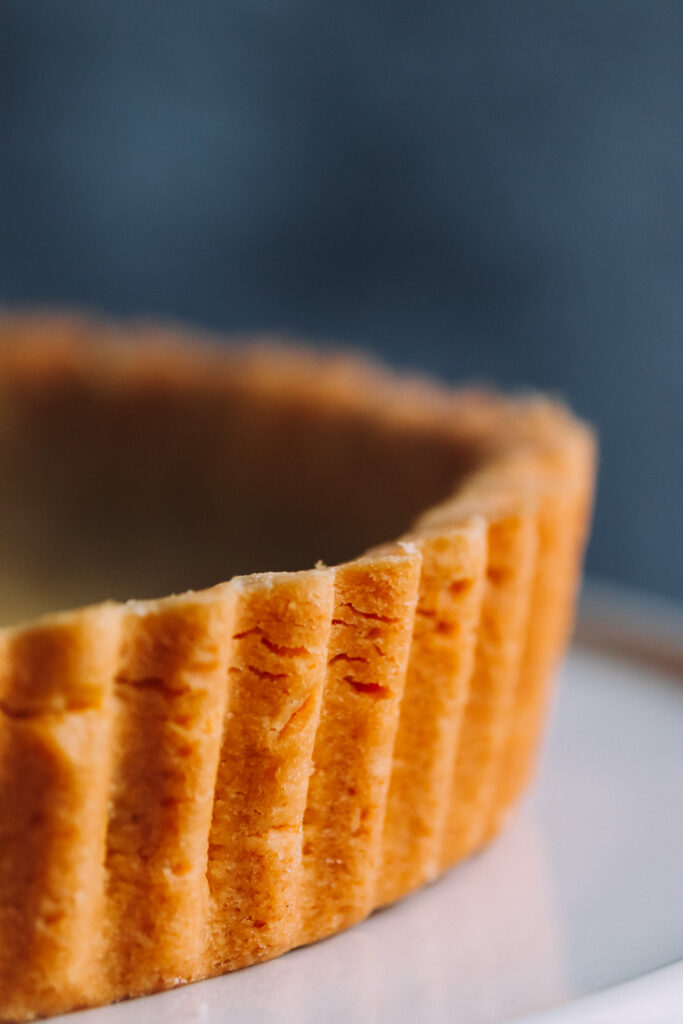
How To Prevent Dough Shrinkage
There are lots of different ways that are supposed to work to help you not end up with an uneven dough that shrinks away from the tin. It has been a journey of discovery to try and get it right with lots of failed tart cases in the process. I have tried the traditional ‘blind baking’ with pie weights. Not great as the pie weights are uneven shaped and leave indentations all over the inner of the cooked tart crust – and it still shrinks. I have used both parchment and tinfoil for lining the tart before weighing it down. I have also tried freezing the dough. All of them have varied levels of success and failure and left me with results I wasn’t happy with. Then I read an article over at Serious Eats on blind baking and gave that a try. Result!
How to Blind Bake
Now I am sharing the best way to blind bake. Use tinfoil. It can mould to the shape of the tart tin so much better than parchment, for a more even shape. You can use a food processor to make this pastry but I prefer to rub the butter in by hand. Think nice and gentle – rubbing in is good practice, creates minimal gluten development and only takes a few minutes extra. Thirdly, use sugar instead of pie weights or rice. The small granules allow it to mould into every nook and cranny of the tart pan meaning a nice uniform crust with the bonus of toasted sugar to use afterwards rather than throwing away rice or beans.
Cooking time – this is the big game changer for me. The standard method is to stick the tart into a high heat with the pie weights to get the crust to set, then remove the weights after 15 minutes or so and finish off the cooking at a lower temperature. The problem with that is the high heat causes the crust to shrink – badly! Try using this method – low and slow. Cooking the crust at a lower temperature and for longer helps to minimize the shrinking but also gets a nice even colour too. I like to try and get a nice light golden crust so I cook my crust at 140°C for an hour. Try these tips next time you make a tart crust…
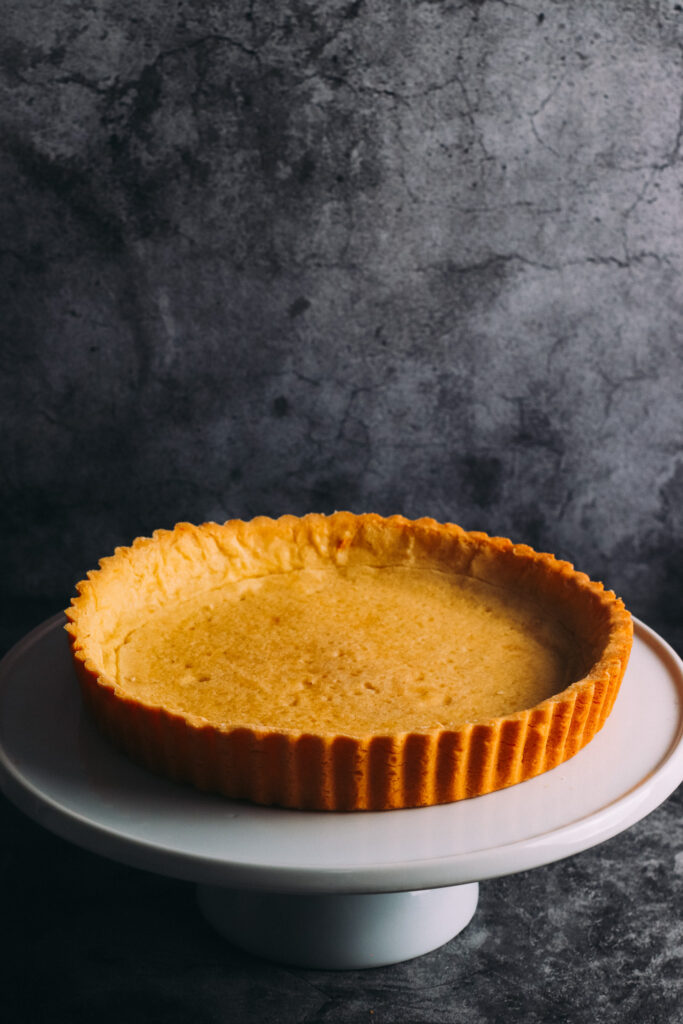
Common Mistakes to Avoid While Making Pate Sablee
While making Pate Sablee, it’s important to avoid common mistakes that can affect the outcome of your crust. Here are a few things to keep in mind:
- Room temperature ingredients: To achieve the desired texture, it’s important to use cold butter and cold water as specified in the recipe. Room temperature ingredients can result in a greasy and dense crust.
- Overworking the dough: When incorporating the ingredients, it’s crucial to handle the dough gently and avoid overmixing. Overworking the dough can lead to gluten formation, which can result in a tougher texture.
- Not letting the dough rest: After mixing the dough, it’s essential to let it rest in the refrigerator. This resting period allows the flavours to meld and the gluten to relax, resulting in a more tender crust. Skipping this step can cause the pastry to shrink during baking.
- Baking at too high a temperature: Pate Sablee should be baked at the proper temperature specified in the recipe. Baking at too high a temperature can cause the crust to brown too quickly, resulting in an unevenly cooked crust.
- By avoiding these common mistakes, you’ll ensure that your Pate Sablee turns out perfect every time, with a delicate and crumbly texture that will make your desserts shine.
Pate Sablee Vs. Other Pastry Doughs
When it comes to pastry dough, there are different types, each with its own unique characteristics. Pate Sablee has its distinct texture, but how does it compare to other popular pastry doughs? Let’s explore the differences between Pate Sablee and two other well-known doughs: Pate Brisée and Pâte Sucrée.
Pate Sablee Vs. Pâte Brisée
Pate Sablee and Pâte Brisée are both delicious pastry doughs, but they have different characteristics. Sablee has a sandy texture, and is perfect for sweet tarts and pies, while Pâte Brisée shines in savoury dishes such as quiches and meat pies. Pate Sablee contains sugar and egg yolks, giving it a sweet taste and delicate texture, while Pâte Brisée is savoury and flaky, with no added sugar. Understanding the differences between these doughs can help you choose the right one for your baking needs, whether you’re making a sweet fruit tart or a savoury pie crust.
Pate Sablee Vs. Pâte Sucrée
With its sandy and crumbly texture, it is often used for tarts and tart crusts, whereas Pâte Sucrée has a softer and more tender texture, making it perfect for pie crusts and sweet doughs. Pate Sablee is made by cutting cold butter into the flour, while Pâte Sucrée is made using the creaming method, where softened butter and sugar are beaten together until creamy. Knowing the differences between these sweet pastry doughs can help you select the perfect one for your baking project.
Expert Tips for Working with Pate Sablee
Now that you are familiar with the process of making Pate Sablee, here are a few expert tips to help you work with this delicate pastry dough like a pro.
Storage and Freezing Advice
To store Pate Sablee, wrap it tightly in plastic wrap and refrigerate it. This will keep the dough fresh for several days, allowing you to bake your tart or pie crust at your convenience. If you want to freeze Pate Sablee for future use, double-wrap it in plastic wrap and place it in an airtight container or freezer bag. Frozen Pate Sablee can be kept for up to 3 months. When you’re ready to use it, thaw the dough in the refrigerator overnight before rolling it out and baking. Proper storage and freezing of Pate Sablee ensure that you always have a delicious crust on hand for your baking projects.
Correcting Common Pate Sablee Issues
Sometimes, even with the best of intentions, issues can arise while making Pate Sablee. Here are some common problems you might encounter and how to fix them:
- Broken pieces of fat. If you notice large pieces of butter in your dough, it’s a sign that the fat hasn’t been evenly distributed. Take a few extra minutes to continue working the dough, gently breaking up the butter until it is evenly incorporated.
- Cold water. If your dough feels too dry and crumbly, try adding a small amount of cold water. About a teaspoon at a time, and gently mix it in until the dough comes together. Be careful not to add too much water, as it can make the dough sticky and difficult to handle.
- Sandy dough: Pate Sablee should have a sandy texture, but if it feels too sandy and doesn’t hold together, try adding a touch more cold water and kneading the dough gently. This will help bind the ingredients together, resulting in a dough that is easier to work with.
- By addressing these common issues, you can salvage your Pate Sablee and end up with a perfect crust for your sweet tart or pie.
Creative Uses of Pate Sablee
Now that you have mastered the art of making perfect Pate Sablee, let’s explore some creative ways to use this versatile pastry dough to impress your family and friends.
Classic Tart Recipes with Pate Sablee
Pate Sablee is a fantastic base for classic tart recipes. Whether you’re a fan of fresh fruit, tangy lemon, or rich chocolate, there’s a perfect tart recipe for you. Imagine biting into a luscious fruit tart, with a buttery Pate Sablee crust holding a medley of sweet and juicy fruits. Or savouring a tarte au citron, with its tart lemon filling complemented by the crumbly texture of the pastry dough. For chocolate lovers, picture indulging in a decadent chocolate ganache tart, where the smooth chocolate filling harmonizes perfectly with the sandy crust. The possibilities are endless with Pate Sablee, and these classic tart recipes will truly showcase its buttery goodness.
Unique Dessert Ideas Using Pate Sablee
Not only is Pate Sablee perfect for classic tart recipes, but it also lends itself to more unique and innovative dessert ideas. For a delightful bite-sized treat, try making mini tarts with different fillings, such as caramel, ganache, or fruit compote. You can also venture into savoury territory and use Pate Sablee as a crust for savoury pies, adding a twist to traditional recipes. The buttery and crumbly texture of the pastry dough creates a delightful contrast with savoury and sweet fillings alike. The possibilities are endless when it comes to using Pate Sablee in your desserts, so don’t be afraid to experiment and let your creativity shine.
Frequently Asked Queries About Pate Sablee
We often receive questions from baking enthusiasts about Pate Sablee. Let’s address some of the most frequently asked queries to help you navigate the world of this delectable pastry dough.
Can Pate Sablee Be Made Gluten-Free?
Yes, Pate Sablee can be made gluten-free by using gluten-free flour or a combination of alternative flours. Popular gluten-free flour options for Pate Sablee include almond flour, rice flour, or a gluten-free all-purpose flour blend. When baking gluten-free, it’s important to ensure that all ingredients used in the recipe are also gluten-free, as even a small amount of gluten can affect the end result. Experimenting with different gluten-free flour combinations can help you achieve the desired texture and flavour in your gluten-free Pate Sablee, ensuring that everyone can enjoy this delightful pastry dough.
What Makes Pate Sablee So Delicate and Crumbly?
The secret behind the delicacy and crumbliness of Pate Sablee lies in its sandy dough and buttery texture. Pates Sablees gets its sandy texture from small pieces of butter distributed throughout the dough. When these pieces of butter melt during baking, they create pockets of air, resulting in the flaky and delicate texture of the pastry crust. The cold butter is cut into the flour, creating small, pea-sized pieces, which remain intact during the mixing process, and gives the dough its flaky texture. The buttery nature of the dough comes from the high ratio of butter to flour, contributing to a rich and indulgent taste.
The small pieces of butter in the dough create a crumbly texture as they melt, resulting in a delightful contrast with the filling. This crumbly texture is what makes Pates Sablees perfect for sweet tarts, pies, and other desserts, as it adds a unique mouthfeel and enhances the overall experience of eating the pastry. By mastering the art of creating a sandy, buttery dough with small pieces of cold butter, you can ensure that your Pates Sablees turns out delicate and crumbly every time, offering a perfect base for your sweet creations.
How To Make Paté Sablée
Equipment
- 1 Rolling Pin
- 1 9 inch fluted tart pan
- 1 large mixing bowl
- tinfoil
Ingredients
- 200 g plain flour
- 125 g cubed unsalted butter
- 75 g icing sugar
- 1 egg yolk
- Pinch of salt
- 1-2 tbsp water
Instructions
- Add sugar and salt to the flour and gently stir to combine
- Chop butter into 1cm cubes and rub into the flour until it resembles wet sand
- Add egg yolk and 1 tbsp of water at a time and incorporate into the flour, checking if it is ready by squeezing a small amount between your thumb and forefinger, if it holds together, it is ready
- Bring dough together with a quick gntle knead into a flat disc shape
- Once ready, roll out to ¼ inch thick and place in tart tin, ensuring the edges and base all contact the tin, leaving a 1 inch overhang from the tin or removing the excess dough with a rolling pin
- Chill for 2 hours in the fridge before cooking
- When ready to cook, line the pastry with foil and fill with sugar
- Place in a 140℃ preheated oven for 1 hour
- Remove the foil and sugar carefully and let the tart case cool completely before removing from the tart tin and using

